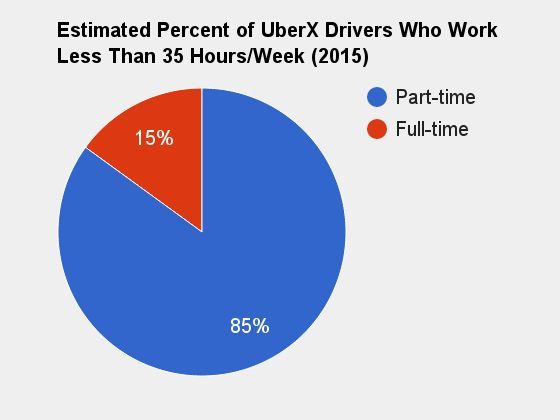The California Labor Commission just ruled that Uber must treat one of its drivers like a normal employee, rather than an independent contractor, potentially forcing the company to pay benefits and cover expenses for other drivers, too. It’s being hailed as a victory for worker rights and a major blow to the growing billion-dollar transportation startup.
However, studies show that the overwhelming number of drivers for UberX are part-time: 85 percent work less than 35 hours a week, by one recent estimate [PDF]. The same is true of many “gig economy” workers, who are joining the growing ranks of delivery, cleaning, and task startups.
Uber and other startups could just limit the number of hours to avoid full-time benefit laws, keeping most of their system functioning, but hurting the few workers who rely most on full-time work.
The Comission held in Uber v. Berwick that because drivers “are involved in every aspect of the operation”, Uber may be liable for things like workers’ compensation, overtime pay, and expenses (the defendant was tentatively awarded money in the ruling).
Broadly speaking, many of the most important benefits, such as health insurance and overtime, only apply to full-time workers. That is why some business have been cutting hours to avoid the new federal healthcare law (“Obamacare”). Such worker rights vary state-by-state, which will complicate life for Uber.
But Uber does not need full-time employees. Discreetly, more than one founder of a ride-hailing technology company has confessed to me that they don’t actually want any full-time workers. It is far more efficient when their drivers just work in the hours between taking college classes or on the trip back from taking their kids to soccer practice.
Indeed, surveys of drivers show that many work part-time for exactly this reason: they have an erratic life schedule that doesn’t permit them to work a contiguous 8 hours or a normal 9-to-5 job. And those that do work full-time often only do so temporarily (if they need to pay an unexpected bill, for instance).
Moreover, because the technology allows people to sign up easily as contractors, many drivers work for multiple companies at the same time (Uber, Lyft, and Sidecar). In the future, most “full-time” workers could be employed by many companies, working part-time for each. Technology is transforming the very concept of a full-time worker.
As for Uber having to pay for gas and other related work expenses, these are already factored into the wages it pays drivers. Uber and Drivers know they have to earn a certain amount to offset the costs of fuel, maintenance and various expenses. Forcing Uber to pay these expenses may just be cut out of the driver’s pay check, without a significant increase in costs to consumers.
We don’t know whether this ruling will hold up to future appeals, or how it will be applied state-by-state. But we should not underestimate the power and ingenuity of a tech company to find loopholes. There will be unintended consequences to this regulation–we just don’t know what they are yet.
For more stories, subscribe to the Ferenstein Wire newsletter here.

COMMENTS
Please let us know if you're having issues with commenting.